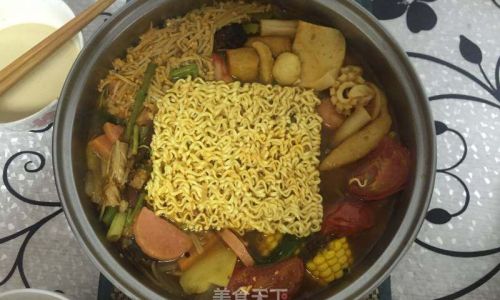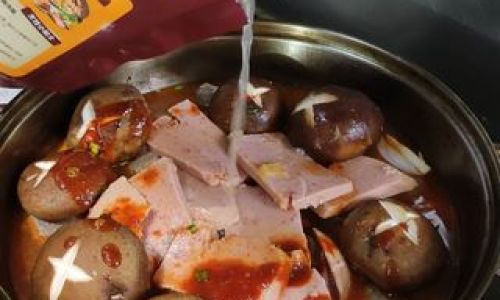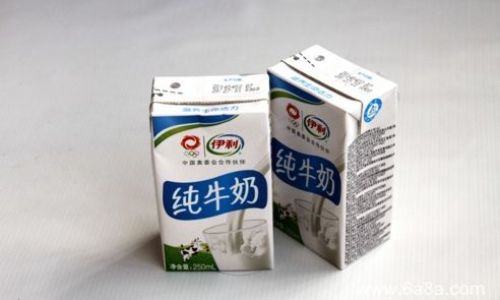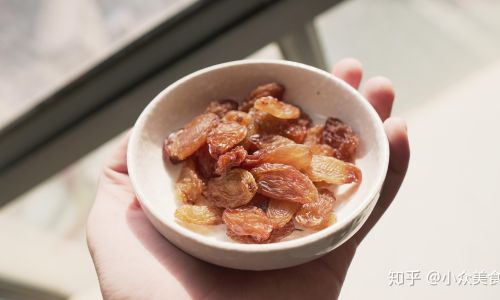Table of content
Budae Jjigae, often dubbed “army stew” or “army base stew,” is a iconic Korean dish that blends post-war ingenuity with bold, umami-rich flavors. Born during the aftermath of the Korean War, this hearty stew combines surplus ingredients from U.S. military bases—such as Spam, canned beans, and processed cheeses—with traditional Korean components like kimchi, gochujang (red chili paste), and ramyeon noodles. The result is a spicy, savory, and deeply satisfying meal that has evolved into a beloved comfort food across South Korea and beyond.

This article will explore the history, cultural significance, and meticulous preparation of Budae Jjigae, ensuring even novice cooks can recreate this culinary masterpiece at home. From selecting the finest ingredients to mastering the art of layering flavors, we’ll delve into every step required to achieve stew perfection.
The Origins of Budae Jjigae: A Tale of Resilience and Innovation
To truly appreciate Budae Jjigae, one must understand its historical context. After the Korean War (1950–1953), South Korea faced widespread food shortages and economic hardship. Local communities near U.S. military bases began scavenging for discarded or surplus rations, including canned meats, cheeses, and hot dogs. Resourceful cooks combined these non-traditional ingredients with Korean staples like kimchi, tofu, and soy sauce, creating a stew that symbolized survival and adaptability.
The dish’s name, Budae Jjigae, directly translates to “army base stew,” referencing its origins. Initially viewed as a humble, makeshift meal, it gained popularity in the 1960s and 1970s as South Korea’s economy improved. Today, it is celebrated as a symbol of cultural fusion, embodying Korea’s ability to transform adversity into culinary creativity.
Ingredients: Balancing Tradition and Convenience
The beauty of Budae Jjigae lies in its flexibility. While the recipe below provides a classic foundation, feel free to adjust quantities or substitute ingredients based on dietary preferences or availability.
Broth Base
- 6 cups anchovy stock or water: For depth of flavor, use dried anchovies and kelp (dashima) simmered for 15 minutes.
- 2 tbsp gochujang (Korean red chili paste): Adjust to taste for spiciness.
- 1 tbsp gochugaru (Korean red pepper flakes): Optional, for added heat.
- 1 tbsp soy sauce: Use dark soy sauce for richness.
- 1 tbsp minced garlic: Fresh garlic is essential for aromatic complexity.
- 1 tbsp sugar: Balances the stew’s saltiness and spice.
Proteins
- 1 can (12 oz) Spam: Sliced into ¼-inch thick pieces.
- 4 hot dogs or Vienna sausages: Sliced diagonally.
- 8 oz baked beans: Drained to avoid excess sweetness.
- 1 cup kimchi: Use aged, fermented kimchi for tanginess.
- 8 oz firm tofu: Cut into cubes.
- 1 cup American cheese slices or processed cheese: Mild cheddar or mozzarella works as a substitute.
Vegetables and Aromatics
- 1 medium onion: Thinly sliced.
- 4 green onions: Chopped into 2-inch segments.
- 1 cup sliced mushrooms: Shiitake or enoki mushrooms add earthiness.
- 1 zucchini: Sliced into half-moons.
- 1 carrot: Julienned for color and crunch.
- 1 cup Napa cabbage: Roughly chopped.
Noodles and Garnishes
- 2 packs instant ramyeon noodles: Discard seasoning packets or reserve for broth.
- 2 sheets nori (dried seaweed): Torn into strips.
- 1 tbsp sesame oil: For finishing.
- 1 tbsp sesame seeds: Toasted for garnish.
Optional Additions
- 4 oz tteokbokki (rice cakes): Soaked in warm water to soften.
- 1 cup enoki mushrooms: Trimmed and separated.
- 1/2 cup canned sweet corn: Drained.
- 4 oz mozzarella cheese: For extra gooey texture.
Cooking Process: Layering Flavors Like a Pro
Preparing the Broth
Begin by simmering the anchovy stock or water with dried kelp for 15 minutes. This forms the stew’s umami-rich base. Strain the broth to remove solids, then whisk in gochujang, gochugaru (if using), soy sauce, minced garlic, and sugar. Taste and adjust seasoning—aim for a balance of spicy, salty, and sweet notes.
Assembling the Stew
Budae Jjigae is traditionally cooked in a shallow, wide pot (or a ttukbaegi clay pot) over a portable burner at the table. This interactive cooking method allows diners to customize their bowls as the stew simmers.
-
Layer the proteins and vegetables:
- Arrange Spam slices, hot dogs, and kimchi around the pot’s perimeter.
- Add baked beans, tofu, and mushrooms in the center.
- Tuck Napa cabbage, zucchini, and carrot slices between the meats.
-
Pour the broth:
Slowly ladle the seasoned broth into the pot, ensuring ingredients are submerged but not crowded.
-
Add cheese and noodles:
- Place American cheese slices or shredded mozzarella on top.
- Nestle the ramyeon noodles into the broth, breaking them into smaller pieces if needed.
Simmering and Serving
Bring the stew to a gentle boil over medium heat, then reduce to a simmer. Cover the pot and cook for 10–15 minutes, or until the noodles are tender and the cheese has melted into a luxurious layer.
Pro Tip: For a smoky flavor, briefly char the Spam and hot dogs in a skillet before adding them to the pot. This step deepens their meaty richness.
Finishing Touches
Just before serving, drizzle sesame oil over the stew and sprinkle with toasted sesame seeds and chopped green onions. Serve with classic Korean banchan (side dishes) like kimchi, pickled radish, and steamed rice.
Customization: Making Budae Jjigae Your Own
One of the stew’s greatest strengths is its adaptability. Here are popular variations:

- Vegetarian Budae Jjigae: Replace Spam and hot dogs with grilled tofu, king oyster mushrooms, and vegetarian “meat” crumbles. Use vegetable stock and omit cheese for a plant-based twist.
- Seafood Budae Jjigae: Add shrimp, squid, and clams during the final 5 minutes of cooking. Squeeze fresh lemon juice over the stew for brightness.
- Spicy Pork Budae Jjigae: Substitute Spam with thinly sliced pork belly or spicy sausage. Marinate the pork in gochujang, soy sauce, and rice wine for 30 minutes before cooking.
Troubleshooting Common Issues
-
“My broth tastes bland!”
Budae Jjigae relies on layered seasoning. Ensure each component—kimchi, gochujang, soy sauce—is adequately seasoned. If needed, add a splash of fish sauce or a pinch of salt. -
“The noodles are too soggy!”
Avoid overcooking. Add the noodles during the last 10 minutes of simmering and stir gently to prevent clumping. -
“The stew is too greasy!”**
Blot excess fat from Spam and hot dogs with paper towels before cooking. For a lighter version, use lean ham or turkey bacon.
Pairing Suggestions: Beverages and Sides
Budae Jjigae’s bold flavors pair beautifully with crisp, refreshing beverages:
- Soju: Korea’s iconic spirit cuts through the stew’s richness.
- Cass Beer: A light lager complements the dish’s spiciness.
- Citron Tea (Yuja-cha): A warm, non-alcoholic option for balancing heat.
For sides, serve:
- Steamed white rice: To soak up the broth.
- Kimchi pancakes (Kimchijeon): For textural contrast.
- Spicy cucumber salad (Oi Muchim): Adds a cooling, acidic element.
The Cultural Experience: Sharing Budae Jjigae
In Korea, Budae Jjigae is often enjoyed communally, with friends or family gathered around a simmering pot. The act of cooking and sharing the stew fosters connection, making it a staple at gatherings, late-night meals, and winter feasts.
To replicate this experience at home, set up a portable burner on your dining table and let guests customize their bowls with extra toppings like fried eggs, extra cheese, or fresh herbs.
Health Considerations: Moderation and Balance
While Budae Jjigae is undeniably indulgent, it can be part of a balanced diet. Opt for leaner proteins like chicken sausage or reduce the cheese quantity. Incorporate extra vegetables—spinach, bean sprouts, or bell peppers—to boost fiber and vitamins.
For those monitoring sodium intake, use low-sodium soy sauce and rinse canned ingredients like baked beans before adding them to the pot.
Conclusion: A Dish That Transcends Time
Budae Jjigae is more than a stew—it’s a testament to human resilience and culinary evolution. From its humble beginnings as a survival meal to its status as a global comfort food, this dish invites diners to savor history with every spoonful.
Whether you’re a seasoned chef or a curious beginner, mastering Budae Jjigae offers a rewarding journey into the heart of Korean cuisine. So gather your ingredients, fire up the stove, and prepare to create a meal that warms the soul and bridges cultures.
Final Tip: Leftovers reheat beautifully! Store the stew in an airtight container for up to three days, and enjoy it with a fried egg on top for a next-day twist.
Now, armed with this guide, you’re ready to embark on your Budae Jjigae adventure. Happy cooking!





0 comments